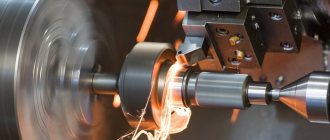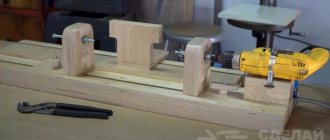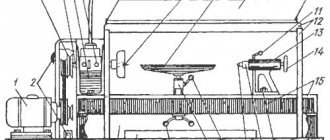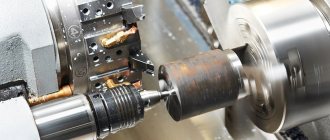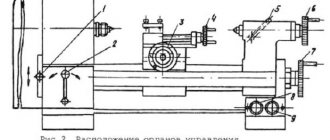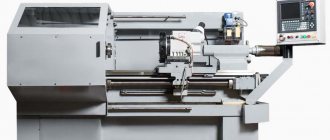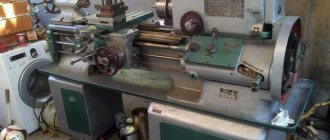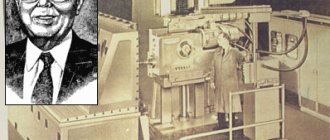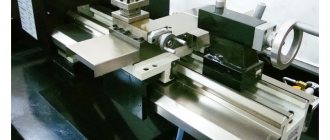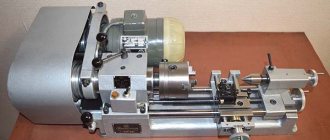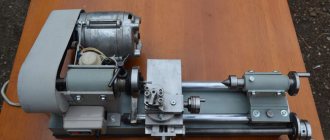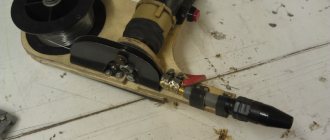Foundation, description of foundation preparation technology for CNC lathes
General requirements for the foundation. The foundation serves as the foundation of the machine, ensuring maximum use of its capabilities in terms of productivity and accuracy over a long period of time, eliminating the influence of the machine on the operation of neighboring equipment. To do this, it is necessary that the foundation, with a convenient placement and strong fastening of the machine, meets the requirements for ensuring the level of vibrations transmitted from the machine. The rigidity of fixing the machine to the foundation has a significant impact on the accuracy of the machine when cutting. The main requirement for installing a high-precision machine on a foundation is to provide reliable protection against vibrations on the floor on the foundation, that is, a vibration isolation device. The foundation for the machine must be made in accordance with the specifications for the foundation specified in the documentation for the machine. Fastening parts (anchor bolts) for installing the machine on the foundation are supplied with the machine or must be manufactured by the buyer of the machine in accordance with the attached documentation.
Factors determining how to install the machine
Correct installation of machines determines the quality indicators of their work. In this case, you should decide on a suitable foundation.
Strengthening the floor for machine installation
Foundations for machine tools are divided into two groups:
- the first (I) consists of bases that are only a support (ordinary floor);
- The second (II) includes separate foundations rigidly connected to the machine.
Any base is designed to distribute the load from the machine, determined by its mass and the forces arising during its operation. The foundation must provide a reliable, stable position for the equipment.
The choice of equipment installation method (on a separate base or directly on an existing floor) is determined by the following factors:
- weight of the machine (static load);
- required precision of parts processing;
- the magnitude of dynamic loads;
- operating mode of the equipment;
- load-bearing characteristics of the ceiling or floor, as well as the properties of the soil located underneath it;
- rigidity of the bed of any machine.
The table below shows machine equipment, divided according to various criteria, with reference to the foundation group.
Regardless of whether the machine will be installed on the floor or a special foundation, its verticality and horizontality must be ensured during installation.
If, according to one criterion (for example, load, operating mode), the equipment does not correspond to the first group of foundations, then it should be placed on a separate foundation.
Technical conditions for the manufacture of the foundation.
For normal precision machines: Soil bearing capacity 5kg/m2. If necessary, load the foundation with an additional load (concrete blocks, blooms, etc.) exceeding the weight of the machine by 3-4 times and check the elevation marks with a level on a benchmark not connected to the foundation every day until the end of shrinkage. For high-precision machines: The foundation must be made with free side edges and heavy concrete of design grades must be used with a compressive strength of 150-200 kg/cm2. To fill the foundation, use a concrete mixture with a volume ratio of cement-sand-crushed stone of 1:1:3 (concrete grade not lower than M250). Foundation depth H > 0.6 √F, where F is the area of the foundation. The foundation is reinforced with a single lattice along the length, width and height with a cell size of 200 mm. The diameter of the reinforcement depends on the size of the foundation and can be from 12 mm to 20 mm. Strength of foundation concrete. Installation of the machine can be allowed when the concrete reaches a compressive strength of at least 50% of the design strength (approximately corresponding to seven-day concrete). By the time the machine is started, the concrete strength should be at least 70% of the design strength (approximately equivalent to 15-day concrete). The period for complete hardening of concrete is 28 days. The quality of concrete is controlled by the strength of control cubes 200x200x200 mm. The strength of concrete in a finished foundation can be roughly estimated by sound and impact.
Foundation for a metalworking machine
Under conditions of static and dynamic loads that act on the foundation, preparing a foundation for a machine is a responsible operation that requires clear design calculations and conscientious adherence to its manufacturing technology.
The total load (including vibrations) transmitted to the area of the supporting sole cannot exceed the bearing capacity of the underlying soil, therefore, depending on the nature of the equipment operation, different foundation designs are chosen for different types of machines.
Base requirements
The foundation for the installation of technological equipment, including machines for mechanical processing of solid materials, despite the need for individual calculations in specific operating conditions, must comply with SNiP 2.02.05-87.
General rules for the design of supports for machines that create dynamic loads are formulated as follows:
Massiveness. The more weight the base has, the higher its ability to resist machine vibrations. High strength and rigidity. Resistance to constant and variable loads directly proportionally affects the service life of equipment on this foundation
Rigid mounting is important for high-precision machine tools. Increased resistance to aggressive influences (fuels and lubricants, cooling emulsions, solvents). It is necessary to ensure maximum inertness at least for the top layer of the monolith.
Such characteristics are needed by the foundation in combination with maintaining the minimum permissible deviations in its design dimensions.
Depending on the weight of the machine (up to 10 tons or more) and the accuracy class, it is allowed to use bases of different designs (general, single, vibration-isolated) for them. Vertical sections of such supports are shown in the drawing:
You can place 1 grinding machine or group on thickened belts, specially poured into the workshop floor, as shown in this photo:
When installing machines on the 2nd floor and above, a frame or wall type of basementless foundation is used. They distribute the load through the frame onto the floors or load-bearing walls (support columns). The vibration created by the machine should be minimal for such a support. When installing a milling unit, you can use dampers that dampen frequency vibrations.
Sloping the upper plane of equipment mounting is strictly prohibited.
Otherwise, there will be an uneven distribution of operating loads, which affects the characteristics of the operating machine and has a destructive effect on the mechanism frame and anchors in the base.
Make it for yourself
A metalworking machine in a private workshop is not uncommon. You can make a solid foundation based on SNiP and technical descriptions for a specific type of equipment. The following recommendations will be useful as a reminder:
- light machine models are installed on reinforced concrete grades M200, M300, heavy units - on M300, M400;
- when calculating the sole pressure on the ground, the operating conditions coefficient (from 0.5 to 1) depends on the type of equipment, the soil settlement coefficient (0.7 - 1) depends on its humidity;
- contact of the foundation material with the structural load-bearing elements of the building is undesirable - it is necessary to leave a gap, arrange a damping cushion of crushed stone or oak beams;
- anchors for attaching the machine are located no closer than 0.2 m to the edge of the base;
- in heated workshops the depth of laying is 0.5 - 0.7 m, in unheated rooms the freezing depth is + 0.25 m (minimum);
- Concrete compaction during pouring is carried out in layers, 0.15 m thick.
It is better to plan the location of the dimensional mechanism before pouring the floor at the intended location of its installation, as shown in this photo:
An example of self-made foundation for a TV-6 lathe (step-by-step operations) is shown in this video:
Like all types of concrete foundations, the foundation for equipment needs to be waterproofed, reinforced and adhere to the deadlines for strengthening the monolith (27 - 30 days) before installing the machine on it.
Permissible deviations from the construction specifications.
The construction task is a design task for the development of the foundation and determines the design of only the upper part. The upper part, the surface for installing the machine, must be flat, “smooth”, without slopes or bulges. Permissible deviations: - installation surfaces on the foundation, erected to the design level: Along the plane in any direction +-0.2/500 mm For height -5 mm On slope 1/1000 mm Builders are usually creative in the manufacture of the foundation; the requirements on the drawings are not They read, but they do it according to centimeter construction tolerances. Attention!!!!! A machine installed on the floor in the absence of a foundation without leveling and without fastening to the floor loses its accuracy after a short time, the guides wear out and as a result the machine requires repair. Preparatory work with supports. Preparing wedge shoes involves removing preservative grease, paint and dirt from working surfaces, especially paying attention to inclined ones and those adjacent to the bed. Lubricate inclined surfaces with grease. Installing the wedge shoes to the lowest position. Installation of the machine. Clean the lower surface of the machine bed from preservation and dirt, especially the contact areas of the wedge shoes. Install the machine frame on four auxiliary supports located at the corners of the frame between the foundation anchor wells, according to the documentation, so that the holes in the frame coincide with the centers of the anchor bolts in the foundation anchor wells. The height of the auxiliary supports should be 5 mm less than the height of the wedge shoes in the lower position. Assemble the entire structure of the machine (stand, table, spindle head, tool magazine, telescopic protection) and part of the cabinet that will not interfere with pouring concrete into the anchor wells. Installation and alignment of the machine. Place the machine table in the center of movement. Using a machine level installed in the center of the table in two mutually perpendicular positions, align the machine on four auxiliary supports with an accuracy of 0.1/1000 mm using a jack and steel spacers 0.5 - 1 mm thick. Using anchor bolts with welded washers to support the wedge shoes, screw all wedge shoes to the machine bed (see drawing). The plan area of the anchor well must be larger than the area of the wedge shoe. The wedge shoes must be in the down position. Fill the anchor wells with water to saturate the foundation around the wells. Soak with water for 8 hours. Fill the anchor wells with low-shrinkage concrete of a grade not lower than M300. Compact with a vibrator and manually pour concrete under the wedge shoes so that it stands on the crushed concrete and is poured over the entire bottom surface of the shoe. Keep the concrete poured into the anchor wells constantly wet for 4 days for better hardening. Loosen the fastening nuts on the anchor bolts. Raise the machine using wedge shoes to remove the auxiliary supports. After 7 days of curing the concrete poured into the anchor wells, you can align the machine frame in a horizontal plane in accordance with the quality certificate for this machine using a jack, wedge shoes and a machine level of 0.02/1000 mm. The top of the foundation between the wedge shoes is leveled with cement mortar and “reinforced”. Paint the finally hardened and seasoned foundation with oil-resistant paint to protect it from the destructive effects of oil and coolant. Tighten the nuts on the anchor bolts with a torque wrench to the torque indicated in the table. At the same time, make sure that the level does not change the readings when tightening the nuts evenly.
Foundations for milling machines, machining centers, boring and grinding machines can vary greatly in configuration and requirements, will be discussed in further articles
Preparing the floor for machine installation
In addition to the quality of work, their durability and the service life of the supporting structure underneath them also depend on the correct installation of machine lines or individual units. When installing, in any case, you must be guided by the product data sheet, and especially the installation drawings.
If you plan to place several units of machines in a workshop or workshop, then passages should be left between them, the dimensions of which are regulated by labor protection (safety) rules.
The floor serves only as a base for the machine. In the workshops of enterprises and in home workshops it is mainly cement. Other materials are used much less frequently. There is also a concrete floor with wooden flooring. It is not recommended to install machines on boards, because they can quickly deform under load (if the unit weighs more than 200 kg). In this case, the adjusted position of the equipment is violated, causing associated inconvenience.
The concrete floor for installation of machines must be of a certain thickness corresponding to the magnitude of the future load. If its height does not correspond, then a reinforced screed or a separate foundation is made. They also fill the floor with concrete when there are strong fluctuations in its level in order to level the surface as well as possible.
You can also prepare (fill with the solution, having previously made a recess of the required size) not the entire base, but only a separate place. It will look like a foundation.
For the most efficient use of the available space in a workshop or workshop, as well as in order to increase the convenience of the work process, installation markings are made on the floor. This is especially true when placing several pieces of equipment, which are mounted in transverse or longitudinal rows.
The markings must be made in such a way as to ensure the technological requirements for the maintenance process, as well as safety regulations. Often, large units are placed in the middle of the room so that lifting equipment can be used without problems if necessary. Small devices, for example, milling machines, are usually installed along the walls (across them).
For proper installation, mark the axes of separate units, or the lines defining the location of the rows.
In practice, it often occurs when the preparation of the base is carried out like this:
- mark the placement of the fastening bolts;
- drill holes;
- install anchors;
- they are concreted;
- When the concrete hardens to the required degree, then the mechanisms are installed.
This method makes it relatively easy to set up the machines, securely attaching them to the base. For greater stability during operation and better connection to the floor, the machine base is poured with concrete.
In small workshops, rubber (from a conveyor belt) is often placed under machines (light or medium in weight) on a cement floor.
The equipment is mounted both on floors located directly on the ground and on interfloor ceilings. The main thing is that it meets the requirements for dynamic and static loads.
If the foundation is interfloor slabs, then it is necessary to carry out additional calculations to confirm their sufficient strength.
The following video shows how to place the machine on the floor.
The preparation of floors for the installation of grinding machines or any other type is carried out taking into account the recommendations set out by the manufacturers in the operating instructions for the model being installed. This placement belongs to the foundations of the first group.
An excellent base option is a reinforced concrete floor, because in most cases it has great strength and does not require any preliminary preparation. The equipment is simply placed on its surface, leveled. In other cases, it is necessary to strengthen the base to one degree or another.
MACHINE INSTALLATION
The correct installation and fastening of machines on the foundation largely determines the quality of their work and technical and economic indicators. Machines in the workshop are installed either on a common concrete floor with a thickness of 150...200 mm, or on specially designed foundations. A rigid foundation, rational design, appropriate placement and careful adjustment of machine supports reduces deformation of insufficiently rigid frames, especially when they are large and heavy executive bodies move along them.
